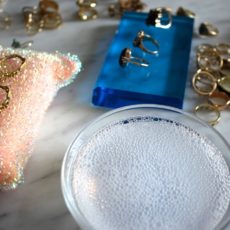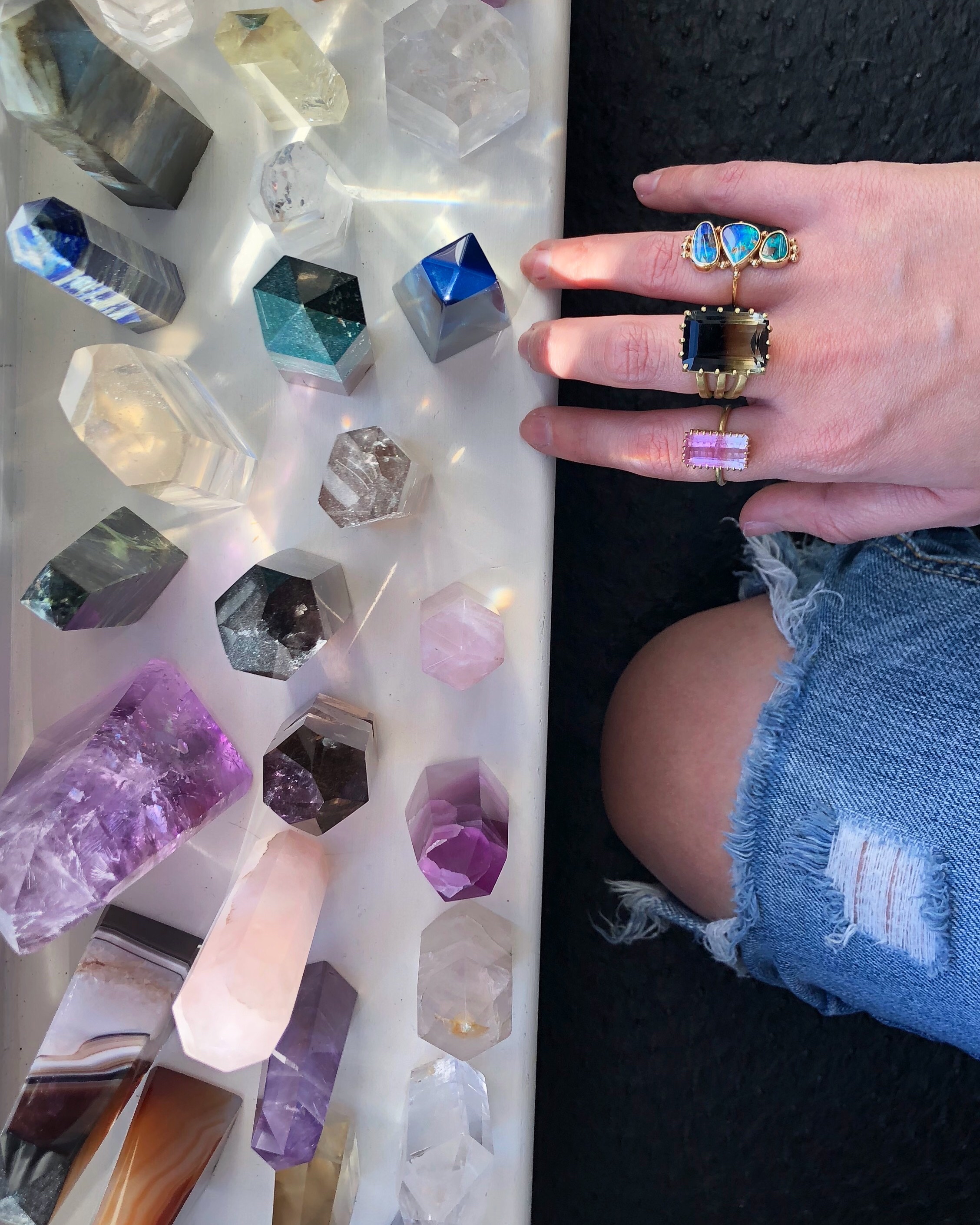I recently found my folders from all my classes and lab courses when I completed my graduate gemologist training at the Gemological Institute of America (GIA). Flipping through the pages instantly refreshed my memory…it is crazy how focused one can be during a time like college or taking a course. I was driven and wanted to learn as much as I could!
A lot of people send me messages asking about GIA and if I recommend it. The short answer is YES, 100%. I’m very lucky to have attended and not only did I learn SO much, but I’ve put what I learned to use tenfold. If gemstones, jewelry, and/or jewelry design are something that you are extremely passionate about, I recommend taking some courses from GIA.
In the meantime, I wanted to post some of my “notes” I took from my GIA Graduate Gemologist coursework to share with all of you:
1 — The dramatic growth of India’s diamond cutting industry was a direct result of the high levels of production from the Argyle Mine in Australia.
2 — A diamond’s grade indicates its quality, while a diamond’s value is largely determined by market factors.
3 — Once a diamond deposit is located, it takes an enormous amount of time and money to analyze and develop it.
4 — The wholesale prices of diamonds on published price lists are usually based on specific combinations of the 4 C’s.
5 — Mountings hide clarity and cut details, and mask color, which is why reputable gem labs do not grade mounted diamonds.
6 — The world’s supply of diamond rough has increased significantly in recent years, making diamonds available to a wider consumer base.
7 — Formation under specific temperature and pressure conditions results in diamond’s supreme hardness, durability, and desirable optical properties.
8 — Cecil Rhodes established De Beers Consolidated Mines Limited in 1888. He had control of the Kimberley area mines.
9 — Ernest Oppenheimer shut down the operation of the De Beers Mines in 1932 because of the low demand for diamonds during the Great Depression.
10 — By 2004, more than 90% of manufacturing for the diamond market was done in India, employing over 1million workers.
11 — The Eureka diamond and the Star of South Africa diamond were found in the 1860s in South Africa.
12 — Before the discovery of South Africa’s diamond deposits, the world’s two major producers were India & Brazil.
13 — Vast quantities of small, inexpensive diamonds suitable for low-cost, mass-market jewelry are mined in Australia.
14 — Before arriving at the Earth’s surface, diamonds might remain in the Earth’s mantle for as long as a few hundred million years.
15 — Most of the world’s Kimberlite Pipes do not contain diamonds in profitable quantities.
16 — Erasmus Jacobs found “a pretty pebble” and gave it to his sister to play with…it ended up being the first authenticated diamond discovered in South Africa and would be later named the Eureka.
17 — During emplacement, if diamonds are exposed to high temperature along with decreased pressure for a long period of time, they will convert to graphite.
18 — Diamonds form 90-120 miles below the Earth’s surface. The conditions necessary for diamond formation is very limited to certain areas of the Earth’s upper mantle.
19 — Diamond deposits found at the ocean’s shore are marine deposits. Strong river currents can carry diamonds all the way to the sea, where ocean currents may wash them back onto the beach.
20 — It’s common for mining companies to leave diamonds in the ground if the deposits don’t contain enough diamonds to make them profitable to mine.
21 — By the 1990s, pipe mines had become the world’s major source of diamonds, although alluvial deposits remained important because of their higher proportion of gem-quality diamonds.
22 — Past and present stream beds were the earliest sources of diamonds. For more than 2000 years, the only known diamond sources were alluvial.
23 — Diamonds are more concentrated in alluvial deposits because the host rock and lighter rock materials erode and wash away, leaving concentrations of diamonds and heavier minerals.
24 — Russia’s diamond production is almost entirely from primary sources, which the government owns and operates as conventional open-pit mines.
25 — When open-pit operation is no longer economical but worthwhile diamonds remain in the pipe, the mine goes underground. Chambering and block caving occur building vertical shafts and horizontal tunnels.
26 — Type IIB diamonds contain boron and little to no nitrogen. This rare chemical makeup produces blue diamonds that are excellent conductors.
27 — Type I diamonds contain nitrogen which causes yellow in diamonds.
28 — A noticeable “oily” appearance seen in some diamonds is usually the result of very strong fluorescence. Even under white light, diamonds with very strong fluorescence can have an oily appearance.
29 — Diamonds with reddish colors are highly valued because of their rarity.
30 — The most commonly observed color of fluorescence in gem diamond is blue, although diamonds can fluoresce in almost any color.
31 — A common method of permanently changing the color of a diamond is irradiating which can yield yellows, browns, greens, blues, even pinks and purples.
32 — Nitrogen is the most common impurity element found in diamond.
33 — Brown diamonds are the most common fancy color and are found in many medium-priced jewelry designs.
34 — The basic causes of a diamond’s color are its crystal structure and chemical composition.
35 — Color-grading diamonds are best graded under balanced daylight-equivalent fluorescent light.
36 — Once a diamond shows more color than the Z color range, it’s classified as Fancy Light Yellow.
37 — An extremely thick girdle adds weight to a diamond without contributing to the stone’s appearance.
38 — The purpose of the culet facet is to prevent chipping and abrasion.
39 — Inclusions are more difficult to see under the facets at the points of hearts, pears and marquise.
40 — The first diamond-bearing emplacement probably occurred more than 2.5 billion years ago. The most recent was probably around 20 million years ago.








Olivia May 28, 2018 at 6:08 am:
very nice blog love it
–Olivia–
https://www.gemstonesilverjewelry.us/collections/moonstone-rings